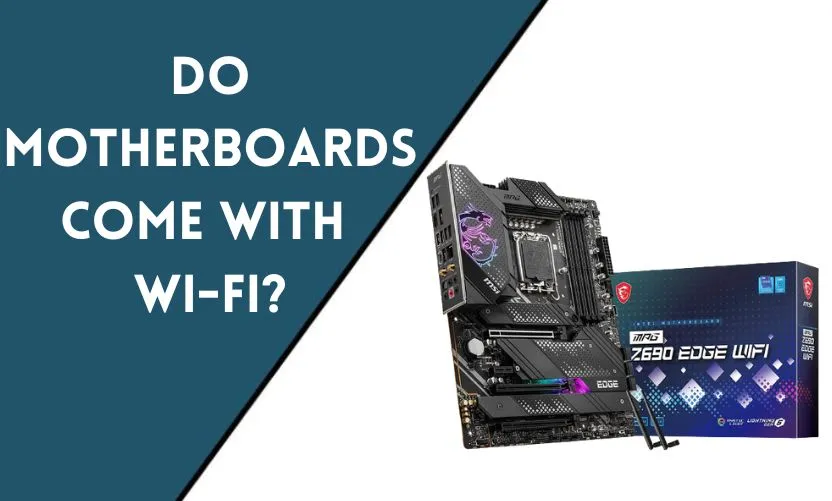
In today’s interconnected world, a reliable internet connection is crucial, and wireless connectivity has become increasingly popular. When building or upgrading a computer, one common question that arises is whether motherboards come with Wi-Fi capabilities. In this article, we will explore the world of motherboards and delve into the topic of whether they come with built-in Wi-Fi.
What is a Motherboard?
Before we dive into the specifics of Wi-Fi on motherboards, it’s essential to understand what a motherboard is. A motherboard is the main circuit board of a computer, connecting various components such as the processor, memory, storage devices, and expansion cards. It acts as a central hub, allowing these components to communicate with each other.
The Importance of Wi-Fi on Motherboards
With the increasing reliance on wireless connectivity, having Wi-Fi capabilities directly on the motherboard can be advantageous. It eliminates the need for additional expansion cards or dongles, providing a convenient and integrated solution for wireless internet access. This feature is particularly beneficial for those who prefer a clutter-free setup or have limited expansion slots available.
Motherboards with Built-in Wi-Fi
Fortunately, there are motherboards available in the market that come with built-in Wi-Fi. These motherboards are designed to provide seamless wireless connectivity without the need for any additional hardware. They often include an integrated Wi-Fi chipset and antenna, allowing users to connect to Wi-Fi networks without hassle.
Benefits of Motherboards with Wi-Fi
Having a motherboard with built-in Wi-Fi offers several advantages. Firstly, it simplifies the setup process, as you don’t need to install a separate Wi-Fi card. This can be particularly helpful for novice users or those who prefer a hassle-free experience. Additionally, it saves valuable expansion slots for other components, such as graphics cards or sound cards.
Another benefit is the potential for improved signal strength and stability. Motherboards with dedicated Wi-Fi antennas may offer better reception and range compared to external dongles or cards. This can result in a more reliable wireless connection, especially in larger homes or offices.
Factors to Consider when Choosing a Motherboard with Wi-Fi
When selecting a motherboard with built-in Wi-Fi, there are a few factors to consider. Firstly, ensure that the motherboard supports the desired Wi-Fi standard, such as 802.11ac or 802.11ax, to take advantage of faster speeds and improved performance.
It’s also important to verify the motherboard’s compatibility with your existing components and system requirements. Check for the necessary expansion slots, such as PCIe, to ensure proper installation. Additionally, consider other features and specifications offered by the motherboard, such as the number of USB ports, audio capabilities, and supported processors.
Installation and Setup of Wi-Fi on Motherboards
Installing and setting up Wi-Fi on motherboards with built-in capabilities is relatively straightforward. Once the motherboard is installed in the computer case and connected to other components, you need to install the necessary drivers provided by the manufacturer. These drivers enable the Wi-Fi functionality and allow you to connect to wireless networks.
The exact process may vary depending on the motherboard model and the operating system you are using. However, manufacturers typically provide detailed instructions in the user manual or on their support websites. Following these instructions will guide you through the installation and setup process step by step.
Troubleshooting Wi-Fi Issues on Motherboards
While motherboards with built-in Wi-Fi are designed to provide a seamless experience, occasional issues may still arise. If you encounter connectivity problems, there are a few troubleshooting steps you can take.
Firstly, ensure that the Wi-Fi antenna is securely connected to the motherboard and positioned properly for optimal signal reception. You can also try updating the Wi-Fi drivers to the latest version, as manufacturers often release driver updates to address compatibility issues or improve performance.
If the issue persists, it’s worth checking for any conflicts with other software or hardware components. Disabling any conflicting software or temporarily removing conflicting hardware can help identify the source of the problem. If all else fails, reaching out to the motherboard manufacturer’s support or community forums can provide further assistance.
Upgrading Motherboards to Support Wi-Fi
If you have an existing computer without Wi-Fi capabilities and wish to add this feature, you have the option of upgrading your motherboard. By selecting a new motherboard with built-in Wi-Fi, you can enjoy the convenience and benefits of wireless connectivity.
However, upgrading a motherboard requires careful consideration of compatibility with your existing components and system requirements. It may involve reinstalling the operating system, drivers and transferring data to the new motherboard. If you’re not confident in performing these tasks, seeking professional assistance is advisable.
Conclusion
In conclusion, while not all motherboards come with Wi-Fi capabilities, there are options available that offer built-in Wi-Fi. These motherboards provide a convenient and integrated solution for wireless connectivity, eliminating the need for additional hardware. When choosing a motherboard with Wi-Fi, consider factors such as compatibility, Wi-Fi standards, and other features to ensure a smooth experience. Whether you’re building a new computer or upgrading an existing one, having Wi-Fi on the motherboard can enhance your computing experience.
Frequently Asked Questions
Can I add Wi-Fi to a motherboard without built-in capabilities?
Yes, it is possible to add Wi-Fi to a motherboard that doesn’t have built-in capabilities. You can do so by installing a separate Wi-Fi card or using a USB Wi-Fi dongle.
Are motherboards with built-in Wi-Fi more expensive?
Motherboards with built-in Wi-Fi may be slightly more expensive than their counterparts without Wi-Fi. However, the price difference is often relatively small and can vary depending on the specific motherboard model and its features.
What is the difference between Wi-Fi and Bluetooth on motherboards?
Wi-Fi and Bluetooth are both wireless communication technologies, but they serve different purposes. Wi-Fi is primarily used for internet connectivity, while Bluetooth is commonly used for short-range wireless data transfer between devices, such as connecting a mouse or keyboard.
Can I disable the Wi-Fi feature on a motherboard if I don’t need it?
Yes, you can typically disable the Wi-Fi feature on a motherboard through the BIOS settings. Consult the motherboard’s user manual or manufacturer’s support website for instructions on how to disable or enable specific features.
Are there any drawbacks to using built-in Wi-Fi on a motherboard?
While built-in Wi-Fi on motherboards offers many benefits, there are a few potential drawbacks to consider. Some users may prefer using a dedicated Wi-Fi card for more flexibility or to take advantage of advanced features. Additionally, if the motherboard’s Wi-Fi chipset becomes outdated, it may not support the latest Wi-Fi standards or receive driver updates, potentially limiting its long-term compatibility.










